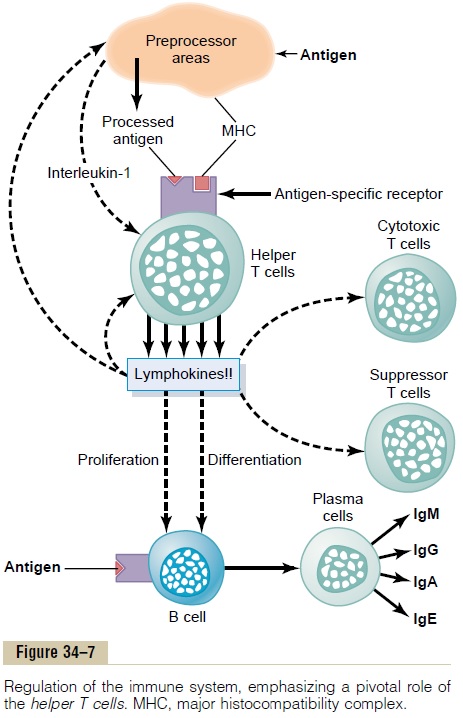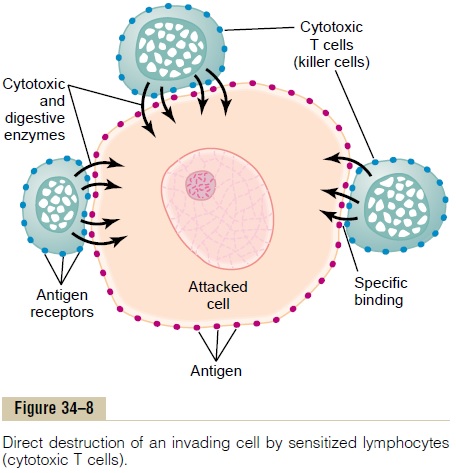Chapter: Medical Physiology: Resistance of the Body to Infection: II. Immunity and Allergy
Several Types of T Cells and Their Different Functions
Several Types of T Cells and Their Different Functions
It has become clear that there are multiple types of T cells. They are classified into three major groups: (1) helper T cells, (2) cytotoxic T cells, and (3) suppressor T cells. The functions of each of these are distinct.
Helper T Cells—Their Role in Overall Regulation of Immunity
The helper T cells are by far the most numerous of the T cells, usually constituting more than three quarters of all of them. As their name implies, they help in the functions of the immune system, and they do so in many ways. In fact, they serve as the major regulator of virtually all immune functions, as shown in Figure 34–7. They do this by forming a series of protein medi-ators, called lymphokines, that act on other cells of the immune system as well as on bone marrow cells.

Among the important lymphokines secreted by the helper T cells are the following:
Interleukin-2
Interleukin-3
Interleukin-4
Interleukin-5
Interleukin-6
Granulocyte-monocyte colony-stimulating factor
Interferon-g
Specific Regulatory Functions of the Lymphokines. In theabsence of the lymphokines from the helper T cells, the remainder of the immune system is almost para-lyzed. In fact, it is the helper T cells that are inactivated or destroyed by the acquired immunodeficiency syn-drome (AIDS) virus, which leaves the body almosttotally unprotected against infectious disease, there-fore leading to the now well-known debilitating and lethal effects of AIDS. Some of the specific regulatory functions are the following.
Stimulation of Growth and Proliferation of Cytotoxic T Cells and Suppressor T Cells. In the absence of helperT cells, the clones for producing cytotoxic T cells and suppressor T cells are activated only slightly by most antigens. The lymphokine interleukin-2 has an espe-cially strong stimulatory effect in causing growth and proliferation of both cytotoxic and suppressor T cells. In addition, several of the other lymphokines have less potent effects.
Stimulation of B-Cell Growth and Differentiation toForm Plasma Cells and Antibodies. The direct actionsof antigen to cause B-cell growth, proliferation, for-mation of plasma cells, and secretion of antibodies are also slight without the “help” of the helper T cells. Almost all the interleukins participate in the B-cell response, but especially interleukins 4, 5, and 6. In fact, these three interleukins have such potent effects on the B cells that they have been called B-cell stimulat-ing factors or B-cell growth factors.
Activation of the Macrophage System. The lym-phokines also affect the macrophages. First, they slow or stop the migration of the macrophages after they have been chemotactically attracted into the inflamed tissue area, thus causing great accumulation of macrophages. Second, they activate the macrophages to cause far more efficient phagocytosis, allowing them to attack and destroy increasing numbers of invading bacteria or other tissue-destroying agents.
Feedback Stimulatory Effect on the Helper Cells Them- selves. Some of the lymphokines, especially inter-leukin-2, have a direct positive feedback effect in stimulating activation of the helper T cells themselves. This acts as an amplifier by further enhancing the helper cell response as well as the entire immune response to an invading antigen.
Cytotoxic T Cells
The cytotoxic T cell is a direct-attack cell that is capable of killing micro-organisms and, at times, even some of the body’s own cells. For this reason, these cells are called killer cells. The receptor proteins on the surfaces of the cytotoxic cells cause them to bind tightly to those organisms or cells that contain the appropriate binding-specific antigen. Then, they kill the attacked cell in the manner shown in Figure 34–8. After binding, the cytotoxic T cell secretes hole-forming proteins, called perforins, that literally punchround holes in the membrane of the attacked cell.

Then fluid flows rapidly into the cell from the intersti-tial space. In addition, the cytotoxic T cell releases cytotoxic substances directly into the attacked cell. Almost immediately, the attacked cell becomes greatly swollen, and it usually dissolves shortly thereafter.
Especially important, these cytotoxic killer cells can pull away from the victim cells after they have punched holes and delivered cytotoxic substances and then move on to kill more cells. Indeed, some of these cells persist for months in the tissues.
Some of the cytotoxic T cells are especially lethal to tissue cells that have been invaded by viruses because many virus particles become entrapped in the mem-branes of the tissue cells and attract T cells in response to the viral antigenicity. The cytotoxic cells also play an important role in destroying cancer cells, heart transplant cells, or other types of cells that are foreign to the person’s own body.
Suppressor T Cells
Much less is known about the suppressor T cells than about the others, but they are capable of suppressing the functions of both cytotoxic and helper T cells. It is believed that these suppressor functions serve the purpose of preventing the cytotoxic cells from causing excessive immune reactions that might be damaging to the body’s own tissues. For this reason, the suppressor cells are classified, along with the helper T cells, as reg-ulatory T cells. It is probable that the suppressor T-cellsystem plays an important role in limiting the ability of the immune system to attack a person’s own body tissues, called immune tolerance, as we discuss in the next section.
Related Topics